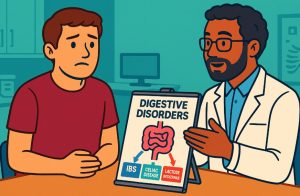Why Am I Suddenly Lactose Intolerant?
Lactose intolerance can feel like it appears out of nowhere, one day you’re enjoying your favourite latte or cheese toastie, and the next, you’re doubled over with cramps or running to the loo. If you’ve recently developed uncomfortable digestive symptoms after consuming dairy, you’re not alone.
Many adults in the UK experience the sudden onset of lactose intolerance, and understanding why this happens can help you manage it confidently and comfortably.
What Is Lactose Intolerance?

Lactose intolerance is a condition in which the body loses its ability to digest lactose, the sugar found in milk and other dairy products. This happens due to a decrease in the production of lactase, the enzyme responsible for breaking lactose down into simpler sugars (glucose and galactose) that can be absorbed by the body.
When lactase levels are too low, undigested lactose moves into the colon, where it’s fermented by gut bacteria. This fermentation process leads to a variety of unpleasant symptoms, including bloating, gas, and diarrhoea.
Lactose intolerance differs from a milk allergy, the latter involves the immune system and can trigger severe allergic reactions, while lactose intolerance is strictly a digestive issue.
Why Does Lactose Intolerance Matter for Your Health?
Though not life-threatening, lactose intolerance can have a notable impact on your wellbeing. Beyond the discomfort, there’s also the risk of unintentionally reducing your intake of key nutrients like calcium, vitamin D, and B12 if you cut out dairy without suitable replacements. Over time, this can affect bone health and overall nutritional balance.
Moreover, untreated symptoms may lead to chronic digestive issues and a reduced quality of life. The embarrassment and inconvenience of sudden symptoms can disrupt work, social events, and even sleep. Therefore, understanding and properly managing the condition is crucial.
What Causes Sudden Lactose Intolerance in Adults?

The development of lactose intolerance in adulthood, especially if it appears suddenly, often comes as a surprise. In reality, it’s quite common and several factors may be responsible.
As people age, their lactase enzyme production naturally decreases. This form of lactose intolerance, known as primary lactose intolerance, is genetic and most likely to develop in adulthood. However, sudden intolerance is often due to secondary lactose intolerance, where an underlying health issue affects the small intestine’s ability to produce lactase.
This can occur due to:
- Gastrointestinal infections (such as gastroenteritis)
- Inflammatory bowel diseases like Crohn’s disease or coeliac disease
- Use of certain medications like antibiotics
- Surgery involving the digestive system
- Chronic stress that alters gut function
In these cases, the lactose intolerance may be temporary, depending on whether the underlying cause is resolved.
What Are the Symptoms of Sudden Lactose Intolerance?

Symptoms of lactose intolerance can vary in intensity and typically occur within 30 minutes to two hours after consuming dairy. What makes lactose intolerance tricky is how similar the symptoms are to other digestive disorders.
Common signs include:
- Abdominal bloating and cramps
- Excessive gas and flatulence
- Nausea or queasiness
- Loose stools or diarrhoea
- A rumbling or noisy stomach
In some people, even small amounts of lactose can cause a reaction, while others may tolerate moderate levels before symptoms appear. Keeping track of symptoms and what you eat is a key part of identifying patterns and narrowing down the cause.
How Is Lactose Intolerance Diagnosed?

If you suspect lactose intolerance, it’s important not to self-diagnose. Consulting a GP or dietitian is recommended for an accurate assessment and to rule out other conditions.
Diagnosis often starts with a discussion about your medical history and recent symptoms. From there, your healthcare provider may suggest one of the following tests:
Hydrogen Breath Test
This is one of the most common and reliable tests. You’ll consume a lactose-rich drink, and your breath is measured for hydrogen levels at regular intervals. A high concentration indicates poor lactose digestion.
Lactose Tolerance Test
This test measures your blood sugar after drinking a lactose solution. If your blood glucose doesn’t rise as expected, it may mean you’re not digesting lactose properly.
Elimination Diet
A temporary dairy-free diet can help confirm lactose intolerance. If symptoms improve during this period and return upon reintroducing lactose, it’s a strong indication of intolerance.
How Can You Manage and Treat Adult Lactose Intolerance?
Living with lactose intolerance doesn’t mean you have to avoid dairy completely. In fact, many people still enjoy small amounts of certain dairy products without discomfort. The key is understanding your personal tolerance level and making thoughtful choices.
Strategies for management include
- Switching to lactose-free products: These include lactose-free milk, yoghurts, and cheeses, which retain the same nutrients without the side effects.
- Taking lactase enzyme tablets: These supplements help digest lactose if taken before consuming dairy.
- Gradually reintroducing dairy: Some people find they can tolerate aged cheeses or yoghurts with live cultures, which are lower in lactose.
- Exploring plant-based alternatives: Oat, almond, soy, and coconut milks are excellent substitutes that are widely available in the UK.
It’s also essential to monitor your calcium and vitamin D intake through fortified products or supplements to maintain bone health.
Could It Be Something Other Than Lactose Intolerance?

Many digestive disorders share similar symptoms, making misdiagnosis a risk without proper medical evaluation. For instance:
- Milk allergy causes immune reactions such as skin rashes, hives, and respiratory issues, and requires strict avoidance of all milk proteins.
- Irritable Bowel Syndrome (IBS) may be triggered by a wide range of foods, including but not limited to dairy.
- Coeliac disease can damage the gut lining, leading to temporary lactose intolerance as a secondary effect.
Infections, stress, or the overuse of certain medications can also alter your gut microbiome and temporarily impair lactose digestion.
What Are the Best Dairy-Free Alternatives Available in the UK?

The UK market has embraced plant-based living, offering a range of lactose-free and dairy-free alternatives that make it easier than ever to live comfortably with lactose intolerance.
| Product Type | Popular Dairy-Free Options | Common UK Brands |
| Milk | Oat, almond, soy, rice, coconut | Oatly, Alpro, Plenish |
| Cheese | Vegan cheddar, mozzarella | Violife, Sheese, Nush |
| Yoghurt | Coconut or soy-based | Koko, Alpro, The Coconut Collaborative |
| Butter | Plant-based spreads | Pure, Flora Plant, Naturli’ |
Many of these alternatives are fortified with calcium and vitamin D, helping you maintain nutritional balance while avoiding symptoms.
How Can You Live Comfortably with Lactose Intolerance in the UK?

Adapting to life with lactose intolerance might feel overwhelming at first, but in the UK, it’s never been easier to make the transition while still enjoying a diverse and satisfying diet. With increasing awareness around food intolerances, British supermarkets, restaurants, and healthcare services now provide more support than ever.
Supermarket Support & Food Label Clarity
Most major UK supermarkets including Tesco, Sainsbury’s, ASDA, Waitrose, and Morrisons — have expanded their Free From ranges. These sections include lactose-free milk, cheese, butter, desserts, and even ready meals. Many plant-based alternatives are also fortified with calcium and vitamin D to ensure nutritional balance.
The UK’s labelling laws require that allergens, including milk, be clearly marked in bold on packaging. This makes identifying lactose-containing foods much easier, even in processed or unexpected products like crisps, sauces, and baked goods.
Dining Out with Ease
Restaurants and cafés across the UK are increasingly accommodating dietary requirements. Whether you’re visiting a chain like Nando’s, Pret a Manger, or a local café, it’s standard practice now to ask staff about lactose-free or dairy-free options.
Vegan menus often overlap with lactose-free choices, though it’s important to double-check if products are made with nut-based or soy-based dairy alternatives rather than simply being dairy-light.
When booking in advance, especially for formal dining or events, it’s helpful to inform the venue of your dietary needs. Many places offer lactose-free alternatives without needing to go fully dairy-free.
Eating Socially and Mindfully
One of the challenges with lactose intolerance is maintaining your social life without awkwardness or discomfort. Here are a few ways to navigate it confidently:
- Host with alternatives: If you’re entertaining, include dairy-free cheeses or plant-based desserts that everyone can enjoy.
- Bring your own: When attending events, it’s perfectly acceptable to bring lactose-free milk or snacks.
- Educate those around you: A little explanation goes a long way, many people still confuse lactose intolerance with allergies.
Over time, you’ll develop go-to meals, brands, and social habits that work for you. The key is consistency, awareness, and preparation.
Online Tools and Support Groups
The UK has a number of online communities, apps, and blogs dedicated to managing lactose intolerance and food sensitivities. Apps like ShopWell or Yuka let you scan product barcodes to identify allergens instantly. Forums such as The IBS Network or Reddit’s r/foodintolerances provide peer advice and recipe sharing.
And remember, being lactose intolerant doesn’t mean you’re alone. According to NHS estimates, millions of people in the UK experience some level of lactose intolerance, which means the demand for solutions is only growing.
What Should You Do If You Suspect You’re Lactose Intolerant?

If you’ve started noticing symptoms like bloating, diarrhoea, gas, or nausea shortly after consuming dairy, your body could be signalling lactose intolerance. However, before jumping to conclusions or making drastic diet changes, it’s important to approach the situation carefully and systematically.
Track Your Symptoms
Begin by keeping a detailed food and symptom diary. Write down everything you eat and drink, including snacks, drinks, sauces, and even supplements. Record how you feel after each meal.
Note the time it takes for symptoms to appear and their intensity. This can help identify whether dairy is the common trigger and whether it’s all dairy or just specific types (e.g., milk vs. cheese).
Over the course of two weeks, you may start to notice patterns. For example, you might find that yoghurt is fine but milk causes discomfort, or that large portions are more problematic than small ones.
Try an Elimination Trial
If dairy seems to be the issue, try a two- to three-week elimination of all lactose-containing products. This includes milk, soft cheeses, cream, ice cream, and any processed foods that list milk-based ingredients such as whey or milk powder.
During this period, observe whether symptoms improve. If they do, reintroduce small amounts of dairy (such as a few spoonfuls of yoghurt or a piece of hard cheese) and monitor your body’s response. Improvement during elimination and symptom return during reintroduction is a strong sign of lactose intolerance.
Consult a Healthcare Professional
It’s always wise to seek the guidance of your GP or a registered dietitian. Not only can they confirm a diagnosis through clinical testing, but they’ll also help you avoid nutritional gaps. They might recommend:
- Hydrogen breath tests or lactose tolerance tests
- Blood work to check for nutrient deficiencies
- Screening for other conditions such as coeliac disease or IBS
They’ll also guide you in choosing the right lactose-free or fortified alternatives to maintain a balanced diet.
Don’t Self-Diagnose Without Support
While it’s tempting to jump into a free-from lifestyle, cutting out entire food groups can lead to unintended consequences, particularly a drop in calcium and vitamin D, both crucial for bone health. That’s why it’s important to replace, not just remove, and to do so under professional supervision where possible.
Plan Long-Term Dietary Adjustments
Once you confirm lactose intolerance, create a plan that supports long-term health and flexibility. This may include:
- Building meals around naturally lactose-free foods
- Incorporating calcium-rich vegetables and fortified products
- Finding go-to brands that suit your lifestyle
- Keeping lactase tablets on hand for occasional indulgences
Remember, lactose intolerance doesn’t have to be limiting. With a little education, planning, and experimentation, you can create a food routine that supports both your health and your taste buds.
Conclusion: Living Well with Sudden Lactose Intolerance
Sudden lactose intolerance can be an unsettling experience, especially if you’ve enjoyed dairy without issues your entire life. But understanding the root causes, recognising the symptoms, and knowing how to adapt can make all the difference.
Whether your intolerance is temporary due to illness or a more permanent shift in your digestion, there are plenty of ways to maintain a balanced, satisfying lifestyle.
The good news is that with the growing availability of lactose-free and dairy-free alternatives in the UK, you’re not short of options. From oat milk flat whites to plant-based cheeses, you can still enjoy your favourite foods without the discomfort.
And with support from healthcare professionals, online tools, and a little trial and error, you’ll soon discover what works best for your body.
Remember, lactose intolerance is manageable. By staying informed, making thoughtful dietary choices, and listening to your body, you can live well, eat happily, and feel your best, every day.
FAQs
Can lactose intolerance start suddenly in adulthood?
Yes. It can develop due to natural ageing, stress, illness, or underlying conditions affecting the gut.
What foods should I avoid if I’m lactose intolerant?
Primarily milk, cream, soft cheeses, ice cream, and any food products containing lactose or milk derivatives.
Is there a cure for lactose intolerance?
There is no permanent cure, but symptoms can be managed effectively with dietary changes and supplements.
How long do symptoms last after eating dairy?
They typically appear within 1-2 hours and can last anywhere from a few hours to a day.
Can stress or illness cause lactose intolerance?
Yes, stress and illness can disrupt gut function, leading to temporary or secondary lactose intolerance.
How can I tell if it’s lactose intolerance or a milk allergy?
Lactose intolerance causes digestive issues, while milk allergy causes immune reactions such as hives or breathing problems.
Are lactose-free products safe for everyone?
Yes, they’re generally safe and offer a suitable alternative for those with lactose intolerance or sensitivity.







